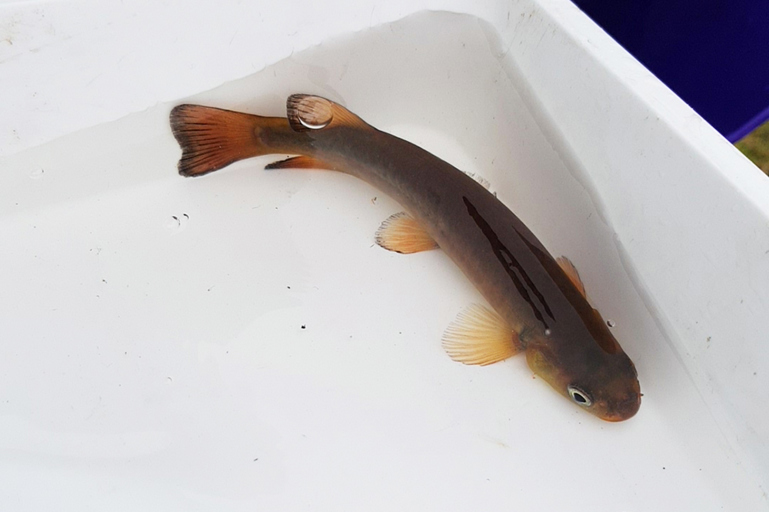Shortjaw kōkopu
The shortjaw kōkopu (Galaxias postvectis) is a native fish that can often go unobserved, due to its shy, nocturnal habits. The fish are mostly nocturnal, meaning they come out at night to feed in pools of slow-moving water and hide during the day in riverbanks and fallen trees in deeper pools. They are so named because of their distinctive undercut lower jaw which allows the fish to graze insects from rocks in streams.
Shortjaw kōkopu are a migratory fish species, meaning they require access to both freshwater and the sea to complete their lifecycle. They are one of the five native species caught as juveniles known as ‘whitebait’, the other four species being īnanga, banded kōkopu, giant kōkopu and kōaro.
The early stages of their life cycle and where they spawn are largely unknown, but we do know shortjaw kōkopu lay eggs in moist leaf litter and gravel on stream banks when water levels are raised after rain in late autumn. In winter the larvae are then washed out to sea. Larvae spend 4-6 months in saltwater developing into juvenile fish which migrate upstream into freshwater from September to November. This is when the juveniles are caught as whitebait.
Shortjaw kōkopu are excellent climbers and as juveniles they can climb steep waterfalls, sometimes reaching 200km inland. They prefer undisturbed, rocky streams with good native vegetation cover, although they can be found in coastal streams, tributaries of larger rivers, and up to 500m above sea level.
The shortjaw kōkopu is classed as Threatened – Nationally Vulnerable and populations are in decline, largely due to human activities, including whitebaiting, removing native forest habitat and upstream vegetation, intensive land-use, decline in water quality, and introduced pests.
Shortjaw kōkopu facts
- One of New Zealand’s five species of migratory galaxiids. The scientific name Galaxias comes from the patterned skin of the adult fish, that looks like a galaxy of stars
- Unsurprisingly, these fish have a distinctive short lower jaw, to enable them to pick insects from rocks in the water
- Nocturnal, hiding during the day and coming out to feed at night
- 15-20cm in length when fully grown
- Live for around 15 years, maybe longer.
Shortjaw kōkopu habitats
- Small to medium sized rivers surrounded by native forest
- Habitats can range from coastal streams to larger rivers and rocky forest streams, up to 500m altitude
- Present in Northland and throughout NZ, although mostly found on the west coasts.
How you can help
If you go whitebaiting, you need to know the current regulations, updated in 2021. See the regulations at: www.doc.govt.nz/whitebaiting
You can find the full Whitebait Fishing Regulations 2021 at: legislation.govt.nz
Whitebait can only be caught between 1 September to 30 October (inclusive) on mainland New Zealand and1 December to the last day of February (inclusive) on the Chatham Islands).
Freshwater pests are already established in some of Northland’s lakes, rivers, and streams. Native fish are seriously threatened by introduced weeds and non-native species.
If you visit our lakes and rivers, you can help to prevent the spread of freshwater pests by using the ‘Check Clean Dry’ method.
CHECK equipment and remove any fragments of plants or weeds
CLEAN all equipment that had been in contact with water
DRY equipment thoroughly and then wait for at least 48 hours before entering water again.



